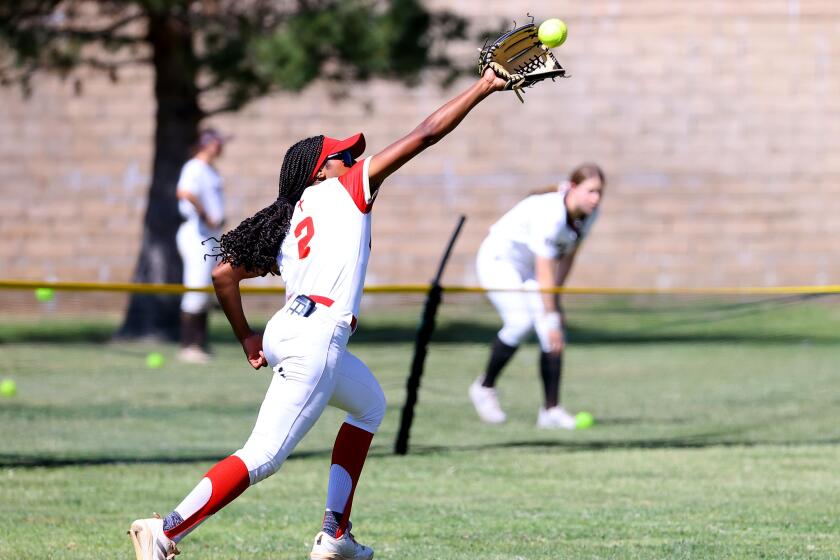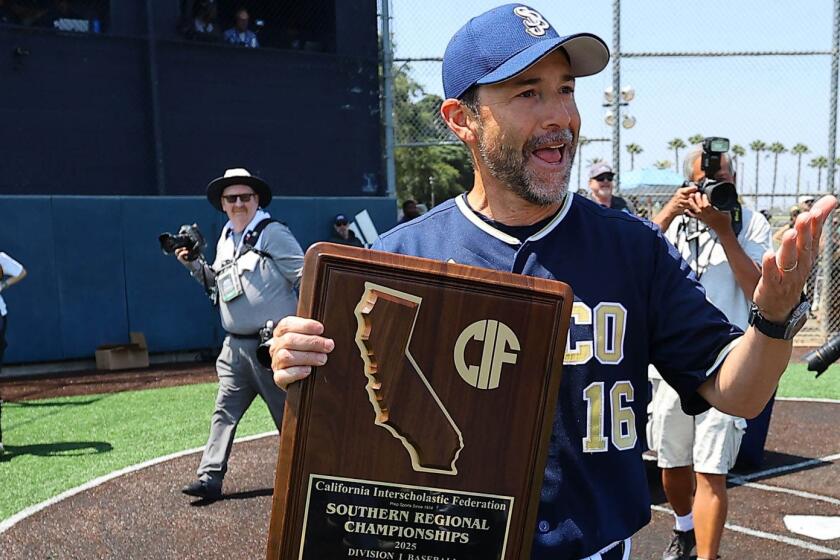Surfing 101 : Although Not Sanctioned by the CIF, the Sport Is Popular at Coastal Schools
- Share via
Danny Nichols knows when he should stop surfing.
“It’s exactly a mile from the beach to school. And if I leave right now, I can make it to class on time.”
As the big clock on Pacific Coast Highway and Main Street in Huntington Beach ticks off the minutes before 8:30 a.m., Nichols starts running across the sand to his car, his surfboard tucked under his arm.
Nichols is a senior at Huntington Beach High, and no, he’s not doing some free surfing before his first-period class. Instead, he’s working out with his surf team as it prepares for the national high school championships next month.
Though surfing is not recognized by the California Interscholastic Federation, the governing body of the state’s high school sports, it thrives nonetheless at the county’s coastal schools.
Huntington Beach is part of the Sunset League, which includes Edison, Fountain Valley, Marina and Ocean View. The South Coast League is made up of San Clemente, Aliso Niguel, Dana Hills and Capistrano Valley.
Surfing has been part of the California lifestyle since it was introduced to the state from Hawaii in the late ‘20s, but it wasn’t until the ‘60s that competitive teams emerged on high school campuses.
Bill Garland, who teaches world history at Huntington Beach, started the school’s first surf club in 1967. At the time, competition was restricted to San Clemente High . . . or Orange Coast College.
“I was a new teacher then, and I wanted to start a surf club at the school,” Garland said. “It seemed like a natural when you considered that Robert August and Corky Carroll both graduated from this school. I put an ad in the local paper, announcing the start of this club, and amazingly I had 70 people come to the first meeting.”
Despite the student interest, Garland said the school and district fought him at every turn. And when his club started to attract some of the school’s star football players, Garland was read the riot act.
“I was new and in hot water,” he said. “Besides the fact that the football players were interested in surfing instead of playing ball, probably the reason for the school and district’s hostility was because of the insurance issue. They had these visions of kids being hurt or drowning. And since it was a club, there was no insurance for the kids.”
Garland coached the Oilers until 1970. That decade, the sport had a resurgence and schools began adding surfing to their physical education curriculum. Today, about 13 county schools offer surfing as a P.E. elective.
Bill Hartman, surfing coach at San Clemente High, said his school has always tried to feature the exploits of the surfing team as prominently as those of its other sports.
“We’re a beach town,” Hartman said. “Surfing is very big here, so we do whatever we can to recognize the sport.”
San Clemente hands out varsity letters to surf team members and displays surfing banners and trophies in the school gym.
One of San Clemente’s more illustrious alumni is Shane Beschen, who was runner-up to Kelly Slater last year for the world surfing title. For Beschen, who lives in Hawaii, high school surfing offered an outlet traditional sports couldn’t.
“I’m a surfer. That’s all I wanted to do, especially when I was in high school,” Beschen said. “So I had the opportunity to do what I like and get credits for it. And it was important to surf against Huntington Beach in the championships. There was a lot of honor at stake.”
Brenden White, a junior at San Clemente, will not surf for his high school next year because he’s turning professional. He said his three years with the Tritons was important to his development on the longboard.
“Surfing for the San Clemente surf team is equivalent to playing for the football team,” White said. “There’s a long tradition that goes with surfing with this team. I mean, the people who have done it . . . You have the Beschens, the McPhillips, Josh Baxter, Dino Andino, Chris Ward, Jeff Kramer and, of course, the McNultys. To surf on this team is a great honor.”
White said like any “big game,” the national high school championships are always the pinnacle of the season.
The National Scholastic Surfing Assn. championships begin June 23 at the Oceanside Pier, and the finals will be June 28 at Lower Trestles in San Clemente.
Janice Aragon, NSSA executive director, said about 11 schools are expected to compete in the team competition and about 200 surfers from across the nation in the individual competition.
And one can’t talk about the NSSA championships without mentioning Huntington Beach High. Andy Verdone has been the Oiler coach the past 10 years, guiding Huntington Beach to nine national titles, including the past six. In all, Huntington Beach has won 15 national titles since the competition started in 1978.
Verdone isn’t worried that surfing isn’t sanctioned by the CIF or Southern Section.
“You know, it would really be great to be recognized by CIF, but I’m not going to lose any sleep over it,” Verdone said. “But maybe it’s better this way. Surfing has always been made up of free spirits. It’s always been against the grain. Besides, we’re getting along fine without them, thank you.”
Nichols, co-captain of the Oilers, isn’t sure he wants his sport to fall under an organization’s jurisdiction. “I don’t know . . . maybe it would be a good thing to be part of, but maybe it would be the worst thing that ever happened to the sport,” he said.
Bill Clark, Southern Section assistant commissioner, said surfing has never been adopted as a section sport because it has never proceeded with the steps needed for sanctioning.
“I think [surfing] was proposed eight or nine years ago, but it died out because it was never followed up,” Clark said. “Besides, I think they feel they are better off without the sanctioning, particularly with the corporate involvement and the Sunday contest and practice sessions.”
CIF rules state no high school can hold practices on Sundays or on Christmas. In addition, no athletes are allowed to accept prize money or exorbitant gifts from sponsors.
Aragon believes surfing’s inclusion as a sanctioned sport could only help it in the long run.
“I think, except for a few schools, the high school surfing scene is pretty chaotic,” Aragon said. “I just got back from Florida, and let me tell you, there was nothing but chaos. There’s no organization. So I think if an organization like CIF were to get involved with surfing, it would create order and would make the sport more accessible to more students.”
Aragon said most high school surfing is nothing more than club surfing and individuals worried about pro careers.
“I don’t know, but it seems to me that most of these kids are more concerned about how well they do individually rather than as a team,” she said. “It’s a fact that the sponsors are more concerned about how well there kids do individually. And the team part isn’t that important.”
Aragon did say Huntington Beach has always believed the team aspect of the competition is the most important, which helps explain why the Oilers are such a powerhouse.
“We get invitations from countries like Australia, that invite the team to their country to surf,” Huntington Beach Principal Jim Staundon said. “They’re invited because they’re known around the world, and that’s quite a feat.”
To earn such respect, the surfers at Huntington Beach put in long hours. Nichols and his teammates report to practice at 6:30 a.m., three days a week. They usually head back to the beach after school. Nichols says he tries to surf seven days a week.
“I surf because I want to. Because I love it,” he said. “Maybe one day I’ll be a top pro, but I also surf for Huntington Beach because there’s a lot of tradition at this school.”
Matt Shadbolt, a senior, said a victory at the national championships would be the perfect ending for his four years with the Oilers.
“The other day I was looking at all the banners and plaques the school has won in the different sports,” Shadbolt said. “Then I looked at the championship banners in surfing. I started to think about it, and here we have a school that has won the national championship 15 times. I was just so stoked.”
Some surf for school pride and tradition, but others have different reasons to be involved. For Capistrano Valley senior David Pinto, 18, it was either surf or run.
“I’d much rather get up early and surf than dress out in gym clothes and run the track in P.E.,” said Pinto, the Cougars’ top surfer. “Surfing fulfills my P.E. requirement and that’s fine with me. Besides, our coach, Bill Steinriede, gets us motivated to get out there early in the morning. And I suppose if I didn’t have that motivation, I’d probably sleep in.”
Pinto, who said he plans to turn pro after the NSSA championships, said his school trains at Salt Creek, sharing the surf break with Dana Hills’ team.
“We have a good team and stuff. And I suppose I get some respect at my school. But a lot of people still stereotype surfers as dumb,” Pinto said.
A professional career is an option for many top prep surfers, and they can use their high school team as a springboard to the pros.
Huntington Beach senior Steve Spagnoli transferred from Calvary Chapel two years ago so he could train with what he called the best team in the nation.
“My parents were bummed when I told them I wanted to come to Huntington Beach,” Spagnoli said. “But I’ve learned so much here. And I hope to turn pro when I graduate. I want to be a professional surfer, and it was very important for me to come to Huntington.”
Although Calvary Chapel has a surf team--one of the few inland county schools to offer the sport--Spagnoli said he preferred the Oilers’ program.
“I’m very serious about surfing,” he said. “On this team, we all push each other, which makes us better competitors.”
Spagnoli said competitions such as the NSSA championships are important because sponsors look at these events when they evaluate surfers for sponsorship.
Ocean Pacific and Huntington Beach Surf and Sport sponsor the Huntington Beach High team. However, individual sponsors abound, and their perks range from providing surfboards to air travel and accommodations for events as far away as Australia and South Africa.
In addition, high school competitors can enter contests in which prize money is awarded. However, any money won is kept in trust funds which the surfers get when they turn pro, generally at age 18.
This summer, Ryan Turner, one of Huntington Beach’s top surfers, is taking a trip to South Africa paid for by Rusty Surfboards. The board he uses is also provided by Rusty.
Turner, who had to present a portfolio to Rusty before he was awarded a sponsorship, said if it weren’t for the sponsors, he and others would not have the opportunity to travel to these competitions.
“I went to Australia a few months ago, and that was so cool,” Turner said. “I’ve never been to a place like that before. But to get the chance to go down there and surf, it’s a dream come true.”
Australian Peter Townend, former world champion who now works for Rusty, sometimes helps Verdone at Huntington Beach practices and during contests.
“Ryan Turner has been a part of this program we have at Rusty for some time,” Townend said. “It was developed by me as a developmental program to help surfers in their sport and career decisions.”
For Verdone, the aspirations of many young surfers is understandable. After all, who wouldn’t want to make a living traveling to exotic places and surfing the best waves in the world?
“These kids read the magazines. They see what their heroes are doing. But it’s very hard to break into the top 44 of surfing,” Verdone said. “And when you think about it, considering all the great surfers Huntington Beach has had, only one, Jeff Deffenbaugh, ever made it [professionally].”
More to Read
Get our high school sports newsletter
Prep Rally is devoted to the SoCal high school sports experience, bringing you scores, stories and a behind-the-scenes look at what makes prep sports so popular.
You may occasionally receive promotional content from the Los Angeles Times.






